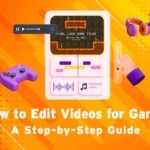
3 Ways to Convert Video to Audio: A Comprehensive Tutorial
Do you have a video bursting with amazing visuals but wish you could extract the audio for a separate project? Maybe you want to create a podcast from a lecture or a voiceover for your next YouTube video. Whatever your reason, to convert video to audio can be a valuable skill, and fortunately, it’s easier than ever!
This process involves extracting the audio stream from a video file and saving it as a separate audio file in a format like MP3, WAV, or M4A. So, lets explore some easy methods to convert video to audio files. We’ll cover online converters, desktop software, and mobile apps – with a special focus on using Vidma Editor App to effortlessly convert video to audio.
We’ll delve into different conversion methods, explore helpful tips for efficient extraction, and ultimately empower you to unlock the audio potential hidden within your video files.
What is Video to Audio Conversion?
In simpler terms, video-to-audio conversion is like separating the sound component from a video file. Imagine a video as a container holding both visual and auditory information. When you convert video to audio, you’re essentially telling the software to extract only the sound data and discard the visuals. This extracted audio can then be saved and used independently for various purposes.
3 Ways to Convert Video to Audio
Here are three popular methods for converting video to audio:
1. Use Online Converters
Online video to audio converters offer a convenient and straightforward way to extract audio from your videos. These web-based tools typically require you to:
a. Upload your video file to the converter’s website.
b. Choose the desired output format (e.g., MP3, WAV).
c. Initiate the conversion process.
d. Download the extracted audio file once complete.
While online converters offer easy accessibility, they often have limitations, such as:
- File size restrictions: Many platforms restrict the size of videos you can upload.
- Security concerns: Uploading your video data to a third-party website may raise security concerns.
- Limited control over the conversion process: You may have little control over settings like audio quality or file size with online converters.
2. Desktop Software
Dedicated desktop software programs offer a more powerful and versatile solution for video-to-audio conversion. These software programs typically allow for:
-
- Batch conversion: Convert multiple videos simultaneously saving time and the effort to individually work on one video.
- Advanced editing options: Adjust audio quality, bitrate, and filesize limits on uploads and other parameters.
-
- Support for various video formats: Most of these softwares are compatible with a wider range of video file types.
For power users, downloading converter software provides robust options for batch audio processing and maximum quality control. For the best quality and flexibility in audio extraction from videos, desktop converter software is a top choice.
However, using desktop software involves downloading and installing the program on your computer, which can be time-consuming and require additional storage space.
3. Vidma Mobile App

Introducing the champion of simplicity and convenience – Vidma Editor for Android and iOS! Our mobile app seamlessly integrates video to audio conversion within its extensive editing toolbox. With Vidma, you can:
a. Import your video: Easily select your video from your phone’s gallery or cloud storage.
b. Access the “Extract Audio” feature: Locate the dedicated “Extract Audio” function within the editing tools.
c. Customize output format: Choose your preferred audio format (MP3, M4A, etc.)
d. Initiate conversion and download: Start the conversion and download the extracted audio file directly to your phone.
Here’s what makes Vidma Editor truly stand out:
-
- Unmatched portability: Convert videos on the go, using your smartphone for an unparalleled level of convenience.
- User-friendly interface: Vidma boasts a simple and intuitive interface, making the process effortless for users of all technical abilities.
- Multiple output formats: Choose from a variety of popular audio formats to suit your needs.
- Offline functionality: No internet connection? No problem! Vidma allows offline video editing, including audio extraction.
Tips and Tricks for Efficient Conversion: Unlocking Audio Magic
Here’s a treasure trove of tips and tricks to elevate your video to audio conversion experience, regardless of the method you choose:
Optimize the Source
-
- Video Quality Matters: The key to high-quality audio lies in your source material. Ensure you’re converting from a good quality video to achieve the best possible outcome.
- Choose the Right Format: Consider the intended use of the extracted audio.
- For general purposes, MP3 offers wide compatibility.
- However, for professional applications or music production, explore lossless formats like WAV or FLAC.
Fine-tuning the Conversion Process
-
- Tweak Audio Settings (Where Applicable): Some conversion tools allow adjustments like bitrate and sample rate. Experiment to find a balance between audio quality and file size.
- Batch Conversion (Desktop Software): If handling a large volume of videos, leverage batch conversion capabilities offered by desktop software to save time and effort.
Organize for Success
-
- Descriptive File Names: Clearly name your converted audio files. This makes them easily identifiable and saves time searching later.
- Consider Software-Specific Features: Explore specific features offered by your chosen method. For instance, Vidma Editor allows you to adjust the starting and ending points of the audio extraction, giving you more control over the final product.
Advanced Techniques (Desktop Software)
-
- Noise Reduction: If your video has background noise, explore noise reduction options offered by certain desktop software programs. This can significantly improve the quality of your extracted audio.
- Normalization: This process adjusts the overall volume of the audio, ensuring a consistent level throughout the file. Many desktop conversion tools offer this functionality.
Go Beyond the Basics
-
- Experiment with Different Tools: If you’re unsure which method suits you best, try different options to discover what aligns with your needs and preferences.
- Explore Online Resources: Numerous online resources offer in-depth tutorials and guides on video to audio conversion. Utilize these resources to expand your knowledge and explore advanced techniques.
Remember: Consistent practice and experimentation are key to perfecting your video to audio conversion skills. Don’t hesitate to try different approaches and explore available features to unlock the full potential of your chosen method.
Conclusion
The ability to convert video to audio opens doors to a world of possibilities, empowering you to:
1. Extract music from videos: Create playlists from your favorite movie soundtracks or video game scores.
2. Craft voiceovers for presentations and educational videos: Enhance your presentations or online courses with engaging voiceovers.
3. Preserve audio memories: Extract the audio portion of personal videos to create lasting audio mementos.
4. Fuel your creativity: Integrate extracted audio into various creative projects, from podcasts and music production to sound effects and experimental art pieces.
The Champion of Convenience: Vidma Editor. For users seeking an unmatched level of accessibility and ease-of-use, Vidma Editor reigns supreme. Its user-friendly interface and intuitive design make video to audio conversion effortless, allowing you to focus on your creative vision without technical complexities.
Download Vidma Editor today and unlock the hidden audio potential within your video files!
Remember, you are not limited to a single method. Explore, experiment, and discover the approach that best empowers your creative journey and unlocks the magic of audio!



